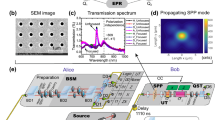Abstract
The state of a two-particle system is said to be entangled when its quantum-mechanical wavefunction cannot be factorized into two single-particle wavefunctions. This leads to one of the strongest counter-intuitive features of quantum mechanics, namely non-locality1,2. Experimental realization of quantum entanglement is relatively easy for photons; a starting photon can spontaneously split into a pair of entangled photons inside a nonlinear crystal. Here we investigate the effects of nanostructured metal optical elements3 on the properties of entangled photons. To this end, we place optically thick metal films perforated with a periodic array of subwavelength holes in the paths of the two entangled photons. Such arrays convert photons into surface-plasmon waves—optically excited compressive charge density waves—which tunnel through the holes before reradiating as photons at the far side4,5,6,7. We address the question of whether the entanglement survives such a conversion process. Our coincidence counting measurements show that it does, so demonstrating that the surface plasmons have a true quantum nature. Focusing one of the photon beams on its array reduces the quality of the entanglement. The propagation of the surface plasmons makes the array effectively act as a ‘which way’ detector.
This is a preview of subscription content, access via your institution
Access options
Subscribe to this journal
Receive 51 print issues and online access
$199.00 per year
only $3.90 per issue
Buy this article
- Purchase on Springer Link
- Instant access to full article PDF
Prices may be subject to local taxes which are calculated during checkout



Similar content being viewed by others
References
Greenberger, D. M., Horne, M. A. & Zeilinger, A. Multiparticle interferometry and the superposition principle. Phys. Today, 22–29 (August 1993)
Bouwmeester, D. et al. Experimental quantum teleportation. Nature 390, 575–579 (1997)
Raether, H. Surface Plasmons (Springer, Berlin, 1988)
Ebbesen, T. W., Lezec, H. J., Ghaemi, H. F., Thio, T. & Wolff, P. A. Extraordinary optical transmission through sub-wavelength hole arrays. Nature 391, 667–669 (1998)
Martin-Moreno, L. et al. Theory of extraordinary optical transmission through subwavelength hole arrays. Phys. Rev. Lett. 86, 1114–1117 (2001)
Ghaemi, H. F., Thio, T., Grupp, D. E., Ebbesen, T. W. & Lezec, H. J. Surface plasmons enhance optical transmission through subwavelength holes. Phys. Rev. B 58, 6779–6782 (1998)
Grupp, D. E., Lezec, H. J., Ebbesen, T. W., Pellerin, K. M. & Thio, T. Crucial role of metal surface in enhanced transmission through subwavelength apertures. Appl. Phys. Lett. 77, 1569–1571 (2000)
Bethe, H. A. Theory of diffraction by small holes. Phys. Rev. 66, 163–182 (1944)
Hecht, B., Bielefeldt, H., Novotny, L., Inouye, Y. & Pohl, D. W. Local excitation, scattering, and interference of surface plasmons. Phys. Rev. Lett. 77, 1889–1892 (1996)
Sönnichsen, C. et al. Launching surface plasmons into nanoholes in metal films. Appl. Phys. Lett. 77, 140–142 (2000)
Kwiat, P. G. et al. New high-intensity source of polarization-entangled photon pairs. Phys. Rev. Lett. 75, 4337–4341 (1995)
Kurtsiefer, C., Oberparleiter, M. & Weinfurter, H. High efficiency entangled photon pair collection in type II parametric fluorescence. Phys. Rev. A 64, 023802-1–023802-4 (2001)
Clauser, J. F., Horne, M. A., Shimony, A. & Holt, R. A. Proposed experiment to test local hidden-variable theories. Phys. Rev. Lett. 23, 880–884 (1969)
Landau, L. D., Lifshitz, E. M. & Pitaevskii, L. P. Electrodynamics of Continuous Media 2nd edn (Pergamon, Oxford, 1984)
Lu, Y. J. & Ou, Z. Y. Observation of nonclassical photon statistics due to quantum interference. Phys. Rev. Lett. 88, 023601-1–023601-4 (2002)
Kimble, H. J., Dagenais, M. & Mandel, L. Photon antibunching in resonance fluorescence. Phys. Rev. Lett. 39, 691–695 (1977)
Acknowledgements
We thank A. van Zuuk and E. van der Drift for the production of the hole arrays, and G. Nienhuis for theoretical discussions. This work was supported by the Stichting voor Fundamenteel Onderzoek der Materie (FOM), and the European Union under the IST-ATESIT contract.
Author information
Authors and Affiliations
Corresponding author
Ethics declarations
Competing interests
The authors declare that they have no competing financial interests.
Rights and permissions
About this article
Cite this article
Altewischer, E., van Exter, M. & Woerdman, J. Plasmon-assisted transmission of entangled photons. Nature 418, 304–306 (2002). https://doi.org/10.1038/nature00869
Received:
Accepted:
Issue Date:
DOI: https://doi.org/10.1038/nature00869
This article is cited by
-
Detection of a plasmon-polariton quantum wave packet
Nature Physics (2023)
-
Identifying the quantum fingerprint of plasmon polaritons
Nature Physics (2023)
-
Mixed-state entanglement for AdS Born-Infeld theory
Journal of High Energy Physics (2023)
-
Surface Plasmons Enhanced Quantum Interference
Plasmonics (2023)
-
Quantum process tomography on holographic metasurfaces
npj Quantum Information (2022)
Comments
By submitting a comment you agree to abide by our Terms and Community Guidelines. If you find something abusive or that does not comply with our terms or guidelines please flag it as inappropriate.



